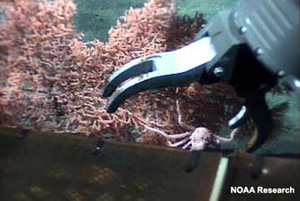

Aleutian Islands Deep Water Corals Cruise, July 26, 2004
(PLEASE NOTE: These web pages are for archival purposes only and are no longer maintained. For current information please refer to the MESA homepage.)
Crab perches in black coral
| |

The manipulator arm of the remotely operated Jason II vehicle closes in on a
black coral and deepwater king crab, found at a depth of 2160 meters just
south of Amlia Island in the Aleutian Island chain during the
first dive of the cruise, Monday, July 26.
|
By science reporter Sonya Senkowsky.
Location: South of Amlia Island.
Using the deep-diving ROV Jason II, scientists observe what may be
the first documentation of a king crab using a black coral colony --
possibly as a feeding platform.
"It may be the first documentation of a king
crab using a black coral colony as a platform, perhaps to feed", said fishery
biologist Bob Stone. During this dive, the scientists observed that king
crabs were often found in the presence of corals, indicating that the crabs
are using the corals as habitat. The coral was collected and preserved by
researchers for study; the crab got away.
The unmanned dive went to a maximum depth of 2900 meters, lasted more than
20 hours and was orchestrated by technicians and NOAA-Fisheries researchers
on board the research vessel RV Roger Revelle. Video from the expedition dives is
being used to better understand Aleutian coral habitat.
Black coral is commercially harvested in shallow water by SCUBA divers in
Hawaii, the Caribbean and New Zealand for jewelry-making. Alaskan black coral is only found in deep waters (below 600 meters)
and is smaller and has a thin flexible skeleton which is brittle when
dried - which makes it not suitable for the jewelry trade;
therefore it is not harvested.
Video of Jason II being brought aboard
As Alaska coral and geology researchers watch from viewpoints overlooking the RV Roger Revelle deck,
the Jason II team uses a crane to retrieve the remotely operated vehicle from the North Pacific Ocean just
south of Amlia Island Monday (July 26). The vehicle's companion piece of equipment, the Medea, has already
been recovered. Video by Sonya Senkowsky.
Note: You need
free
Apple QuickTime to view this video.
|